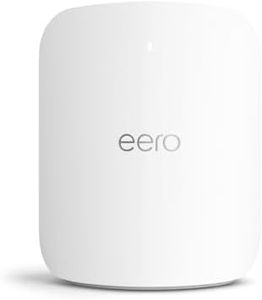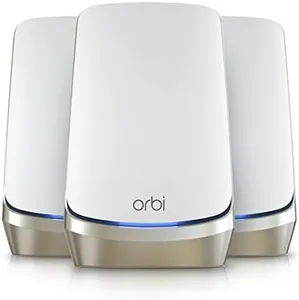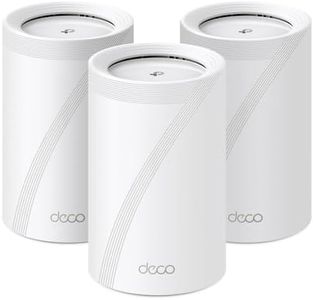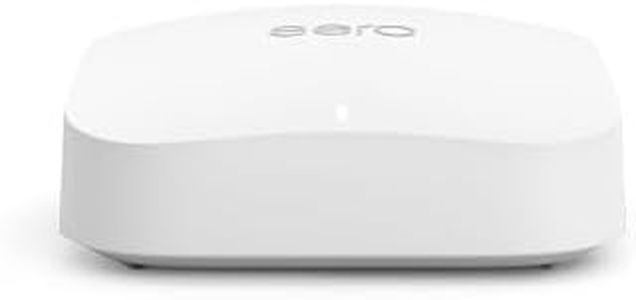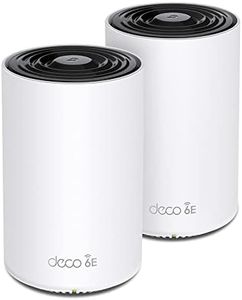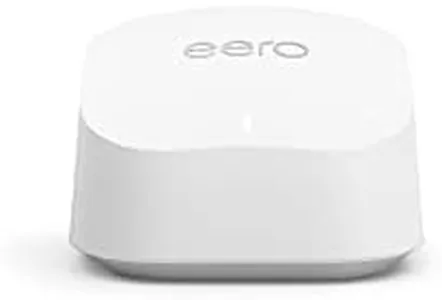We Use CookiesWe use cookies to enhance the security, performance,
functionality and for analytical and promotional activities. By continuing to browse this site you
are agreeing to our privacy policy
10 Best Mesh Wifi Networks
From leading brands and best sellers available on the web.Buying Guide for the Best Mesh Wifi Networks
Choosing a mesh Wi-Fi network system is a smart move if you want smooth, reliable internet coverage throughout your home or workspace, especially if you struggle with dead zones or spotty connections. Mesh systems use multiple devices (called nodes or satellites) to form one large, unified wireless network. When picking a mesh Wi-Fi network, understand your home size, layout, and the types of online activities you do most frequently. Prioritizing the right mix of coverage, speed, and features will help ensure everyone can connect reliably, whether they're streaming, gaming, or just browsing the web.Coverage AreaCoverage area tells you how much space the mesh network can deliver strong Wi-Fi to, usually measured in square feet or meters. This is important because you want all your rooms, including upper floors or basements, to have reliable signal. Systems are often divided into small (up to 3,000 square feet), medium (3,000–5,000), and large (over 5,000). For apartments or small homes, a basic mesh kit may be enough, while multi-level houses or offices may need more nodes. To pick right, tally the areas where you use internet and consider thicker walls or unique layouts that might require extra coverage.
Number of NodesThe number of nodes is how many separate devices make up the complete mesh system. More nodes can blanket bigger or more complex spaces, so this spec matters if your house is sprawling or has challenging spots like garages or attics. Standard kits often include two or three nodes; you usually can add more later. Choose a system that allows easy expansion if you expect your needs might grow or if your home is especially difficult for Wi-Fi coverage.
Wi-Fi Standard (e.g., Wi-Fi 5, Wi-Fi 6)The Wi-Fi standard refers to the overall speed and efficiency of the network. Newer standards like Wi-Fi 6 are faster, handle more connected devices smoothly, and are more future-proof, while Wi-Fi 5 systems are still quite capable for most households. Standards are split: Wi-Fi 5 for solid everyday use and small families, and Wi-Fi 6 if you have many smart devices, gamers, or heavy streamers. To decide, match the standard with how intensely your household uses the internet and what devices you plan to connect.
Maximum SpeedMaximum speed tells you the fastest data transfer the system can theoretically handle, usually in Mbps or Gbps. It's important because it shapes how many devices can stream, game, or video call at once without slowing down. Mesh systems are marked with ranges; entry-level ones deliver basic broadband speeds, mid-tier handle HD streaming and gaming, while top ones support gigabit speeds for demanding use. Choose a system that exceeds your current internet plan—this way, your mesh won’t be a bottleneck as your needs grow.
Backhaul TechnologyBackhaul refers to the way the mesh nodes talk to each other. Dedicated backhaul uses special channels to transmit data between nodes, usually leading to faster and more stable connections, especially important in homes with lots of walls or heavy device usage. Shared backhaul is simpler and usually fine for lighter use or small spaces. If you’ve noticed slowdowns with your current Wi-Fi when moving between rooms, dedicated or wired backhaul can help maintain top speeds throughout.
Number of Ethernet PortsEthernet ports allow you to plug in devices like computers, gaming consoles, or smart TVs directly into the mesh system for the most stable connection. This matters if you have devices that need fast, reliable internet (like for gaming or work). Basic mesh nodes offer limited ports, while some larger nodes have several. Pick a system with enough ports for your needs, or one that allows extra ports via add-ons if you have many wired devices.
Parental Controls and Security FeaturesParental controls and security features help you manage what content can be viewed and protect your network from online threats. Some mesh systems include easy-to-use parental settings to pause Wi-Fi, set schedules, or filter content, as well as security suites that defend against malware. If your household includes children or you’re concerned about threats, focus on systems with robust controls and automatic security updates. This spec is less critical if you handle these features through your devices already.
Ease of Setup and ManagementEase of setup and management describes how simple it is to get your mesh network running and to monitor its performance. Many mesh systems use smartphone apps that guide you step-by-step and let you check device status, set guest networks, or troubleshoot. If you value convenience or feel nervous about setups, pick a mesh system known for its user-friendly app and instructions, rather than ones that rely on more technical, manual settings.


